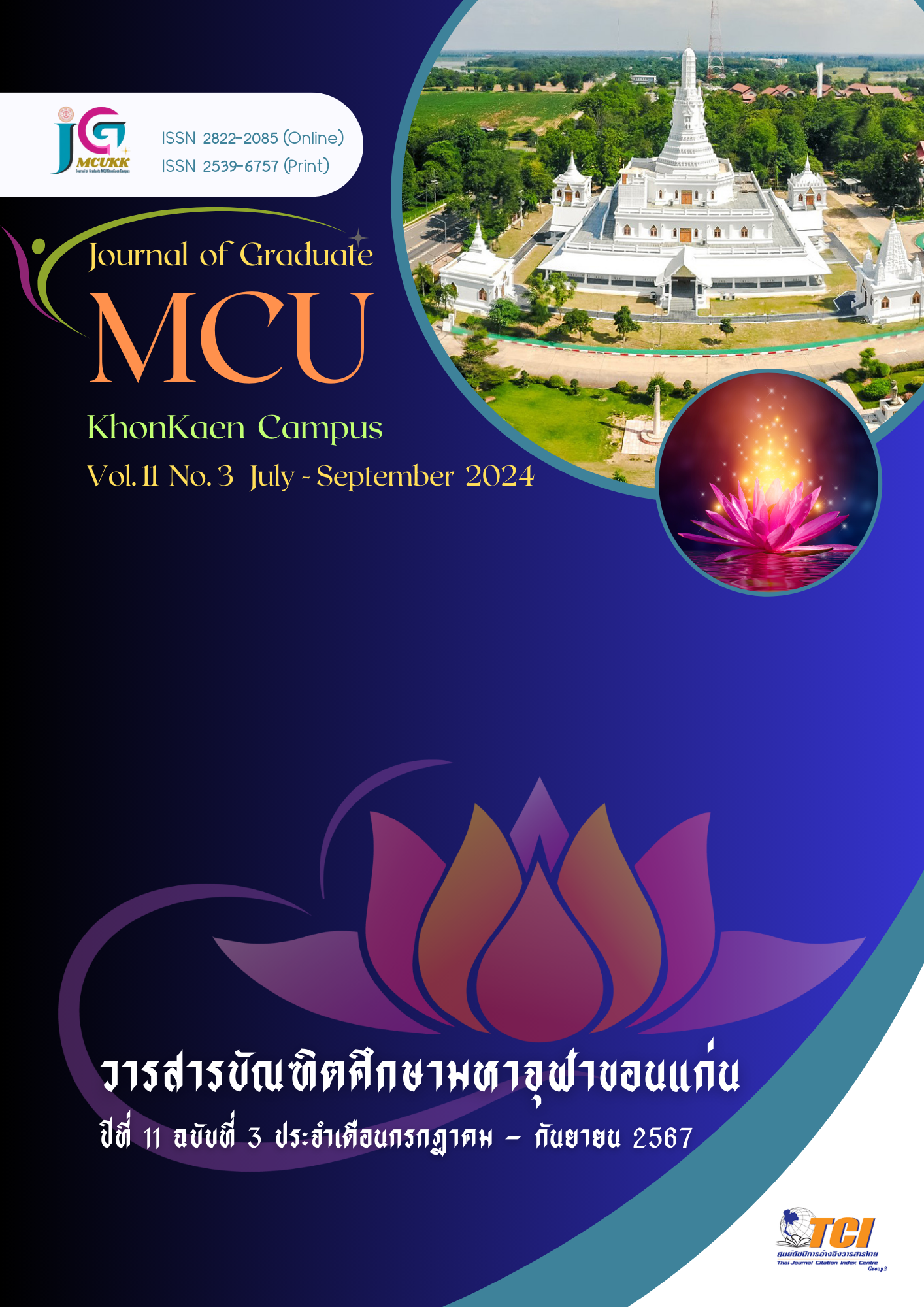Digital Literacy Skill Development Model for Undergraduate Students, Rajabhat University in the Northeast
Main Article Content
Abstract
This research aimed to 1) study the components and indicators of digital literacy skills of undergraduate students of Rajabhat Universities in the Northeast, 2) study the current conditions, desired conditions and needs for the development of digital literacy skills of undergraduate students of Rajabhat Universities in the Northeast, 3) create and develop a digital literacy skills development model for undergraduate students of Rajabhat Universities in the Northeast, and 4) study the results of a tryout of the digital literacy skills development model for undergraduate students of Rajabhat Universities in the Northeast. The research was divided into 4 phases. Phase 1 studied the components and indicators of digital literacy skills. The research tool was an interview form. The target group for the study consisted of 9 experts to confirm the components and indicators. Phase 2 studied the current conditions, desired conditions, and needs of digital literacy skills. The sample consisted of 275 undergraduate students in the second semester of the academic year 2023, from 11 Rajabhat Universities in the Northeast. The research tool was a questionnaire with a total reliability of .87. Data analysis employed the mean and standard deviation. Phase 3 created and developed a digital literacy skills development model. The target group consisted of 9 experts to confirm and assess suitability, feasibility and usefulness of the model. Phase 4 studied the results of the tryout with the digital literacy skills development model. The target group consisted of 30 undergraduate students of Rajabhat Maha Sarakham University. The statistics used in the research included percentage, mean, standard deviation, and Priority Needs Index (PNImodified).
The results of the research revealed that 1) the components and indicators of digital literacy skills of undergraduate students of Rajabhat Universities in the Northeast consisted of 5 components and 18 indicators, including (1) creative skills, (2) practical skills, (3) communication skills, (4) accessibility skills, and (5) assessment skills; 2) the current state of developing digital literacy skills, on the whole, was at a high level (x = 3.47). The desired conditions of digital literacy skills development, on the whole, were at the highest level ( x= 4.73); the need for developing digital literacy skills, on the whole, had a PNI Modified value of 0.34 (PNImodified = 0.34); 3) the digital literacy skills development model had 5 components: principles, objectives, content, processes, and measurement and evaluation. There were 5 learning modules: Module 1: Creative Skills; Module 2: Practical Skills; Module 3: Communication Skills; Module 4: Accessibility Skills; and Module 5: Assessment Skills. The results of assessing the appropriateness, feasibility, and usefulness of the model for developing digital literacy skills, on the whole, were at the highest level ( x = 4.82). 4) The results of using the digital literacy skills development model, on the whole, were at the highest level ( x = 4.62). The satisfaction of the target group with the digital literacy skills development model, was at the highest level ( x = 4.81).
Article Details

This work is licensed under a Creative Commons Attribution-NonCommercial-NoDerivatives 4.0 International License.
References
กระทรวงดิจิทัลเพื่อเศรษฐกิจและสังคม. (2561). กระทรวงดิจิทัลเพื่อเศรษฐกิจและสังคม. สืบค้นเมื่อ 12 มีนาคม 2567, จาก http://library.nhrc.or.th/ulib/dublin.php?ID=10558.
กระทรวงเทคโนโลยีสารสนเทศและการสื่อสาร. (2559). แผนพัฒนาดิจิทัลเพื่อเศรษฐกิจและสังคม. กรุงเทพฯ: กระทรวงเทคโนโลยีสารสนเทศและการสื่อสาร.
ธิดา แซ่ชั้น และ ทัศนีย์ หมอสอน. (2559). การรู้ดิจิทัล : นิยาม องค์ประกอบ และสถานการณ์ในปัจจุบัน. วารสารสารสนเทศศาสตร์, 34(4), 116-145.
บงกช ทองเอี่ยม. (2561). การพัฒนาตัวชี้วัดทักษะการรู้ดิจิทัลของนักศึกษาวิชาชีพครูในมหาวิทยาลัยแบบไม่จํากัดรับ. วารสารวิชาการสถาบันเทคโนโลยีแห่งสุวรรณภูมิ, 4(1), 291-302.
พรชนิตว์ ลีนาราช. (2560). ทักษะการรู้ดิจิทัลเพื่อพัฒนาคุณภาพการเรียนรู้. วารสารห้องสมุด, 61(2), 76-92.
พิสุทธิ์ ศรีจันทร์. (2562). การศึกษาสภาพแวดล้อมการเรียนรู้ทางดิจิทัลเพื่อพัฒนาทักษะการรู้ดิจิทัลของ นักศึกษา กรณีศึกษามหาวิทยาลัยราชภัฏอุตรดิตถ์. วารสารวิทยสารสนเทศและเทคโนโลยี, 3(2), 1-15.
พีรวิชญ์ คำเจริญ และ วีรพงษ์ พลนิกรกิจ. (2561). เด็กกับการรู้เท่าทันดิจิทัล. วารสารวิชาการ นวัตกรรมสื่อสารสังคม, 6(2), 22-31.
วรพจน์ วงศ์กิจรุ่งเรือง และ อธิป จิตตฤกษ์. (2556). ทักษะแห่งอนาคตใหม่การศึกษาเพื่อศตวรรษที่ 21. (พิมพ์ครั้งที่ 2). กรุงเทพฯ: โอเพ่น เวิลต์ส พับลิชชิ่ง.
วิทยา ดำรงเกียรติศักดิ์. (2557). การรู้เท่าทันสื่อดิจิทัล 2. สืบค้นเมื่อ 12 มีนาคม 2567, จาก http://www.infocommmju.com/icarticle/images/stories/icarticles/ajwittaya/digital/Digitalliteracy2.pdf
สำนักงานเลขาธิการสภาการศึกษา. (2560). แผนการศึกษาแห่งชาติ พ.ศ.2560-2579. กรุงเทพฯ: พริกหวานกราฟฟิค จำกัด.
สุภารักษ์ จูตระกูล. (2559). ครอบครัวกับการรู้เท่าทันสื่อดิจิทัล (Digital Literacy) ของดิจิทัลเนทีฟ (Digital Natives). วารสารวิทยาการจัดการ มหาวิทยาลัยราชภัฏเชียงราย, 11(1), 131-150.
อมรพงศ์ สุขเสน. (2566). การพัฒนาเกมดิจิทัลตามแนวคิดผู้เรียนเป็นสำคัญเพื่อส่งเสริมความฉลาดทางดิจิทัล ของนักเรียนระดับชั้นมัธยมศึกษาตอนต้น. (วิทยานิพนธ์การศึกษามหาบัณฑิต). กรุงเทพฯ: มหาวิทยาลัยศรีนครินทรวิโรฒ.

